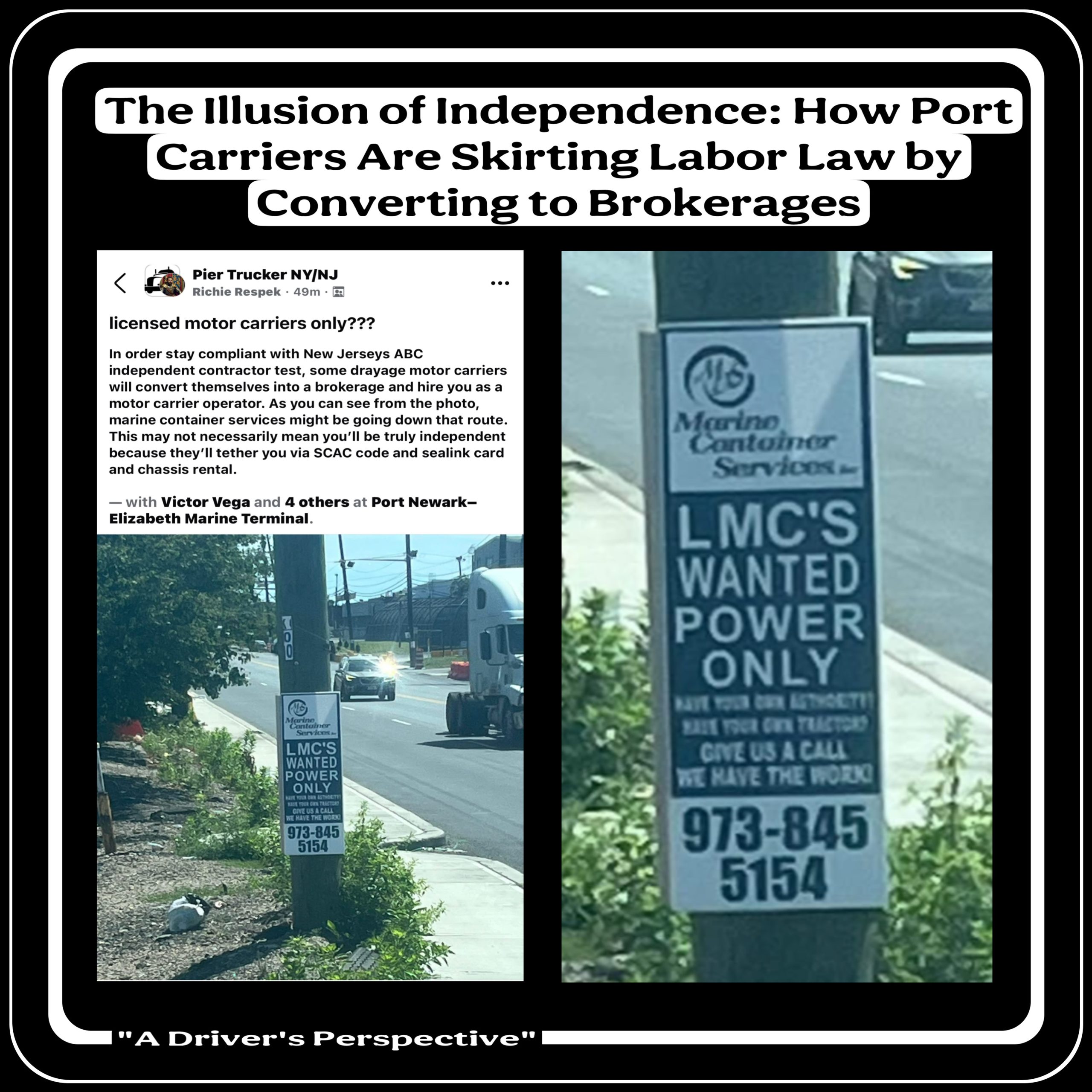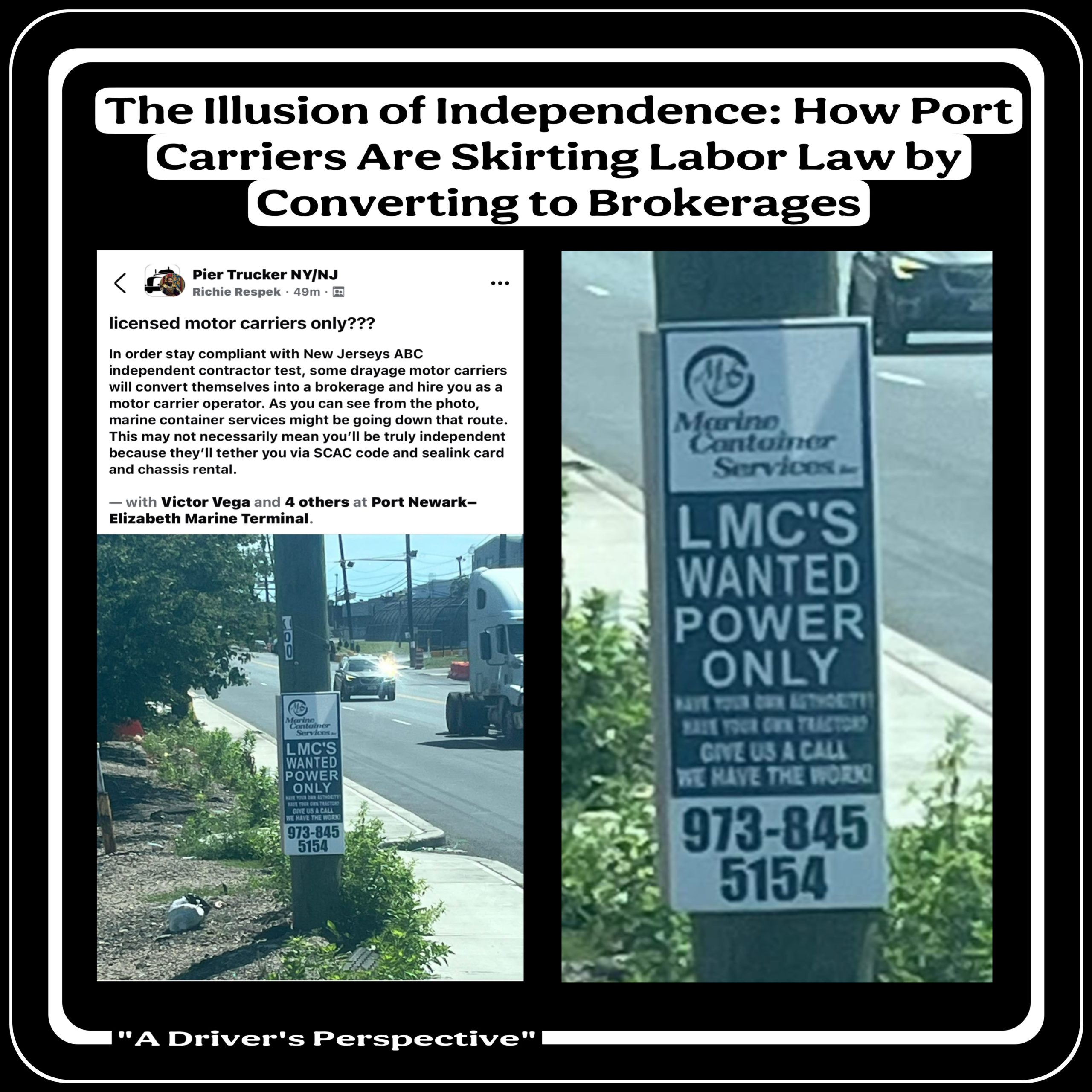
The Illusion of Independence: How Port Carriers Are Skirting Labor Law by Converting to Brokerages
At first glance, the flyer stapled to the utility pole outside Port Newark’s Elizabeth Marine Terminal looks like just another freight opportunity. It reads:
“LMCs Wanted – Power Only. Have your own authority? Have your own tractor? Give us a call. We have the work.”
The company behind the ad, Marine Container Services, isn’t just advertising for trucks – they’re advertising for Licensed Motor Carriers only. That distinction isn’t random. It’s part of a growing trend in New Jersey and across the country where drayage companies are converting themselves into brokerages to stay compliant with new labor classification laws – most notably the ABC test.
But beneath this restructuring is a familiar game: preserve corporate power, shift liability onto the driver, and keep all the leverage – all while claiming it’s in the name of “independence.”
Let’s break this down.
What Is the ABC Test – and Why Are Carriers Reacting?
New Jersey has adopted the ABC test to determine whether a worker is truly an independent contractor or should be classified as an employee. Under this standard, a worker is considered an employee unless:
A) They are free from control or direction over their work,
B) The work is performed outside the usual course of the business, and
C) The worker is customarily engaged in an independently established trade or business.
That “B” prong is critical – because if the worker’s job is the core business of the company (say, hauling freight for a motor carrier), then that worker doesn’t pass the test. And that means the company may be liable for taxes, benefits, workers comp, unemployment insurance, and more.
Rather than absorb those costs or bring drivers on as employees, some companies – especially in drayage and port operations – are choosing to restructure themselves as freight brokers.
Instead of contracting with owner-operators directly, they now say: “We only contract with motor carriers.” In theory, this places the driver outside the ABC test – because they’re no longer performing core work for a motor carrier. They’re a separate company doing work for a broker.
But the reality is far more complicated.
The Tethered Independence Model: SCACs, Sealink Cards, and Chassis Control
Drivers who sign on with these “broker-converted” operations quickly find out they’re still functionally dependent:
- SCAC codes: Port terminals still require a Standard Carrier Alpha Code to process freight. Often, the driver is forced to operate under the broker’s SCAC – not their own.
- Sealink cards: Access to marine terminals is restricted. Drivers may need to be pre-approved or operate under the broker’s umbrella.
- Chassis rentals: Many brokers still control the chassis used for containers, renting them back to the drivers – often with restrictions or fees.
So even though you’re technically a Licensed Motor Carrier (LMC) under your own authority, you’re still reliant on the broker’s infrastructure to move freight. You don’t set your own rates. You don’t access your own customers. You’re still waiting on dispatch. You’re still controlled.
This is not independence. It’s rebranded servitude.
What This Means for the Industry — and for Labor Enforcement
What we’re witnessing is a legal shell game:
- The corporation avoids liability by shifting the relationship from employer-contractor to broker-carrier.
- The state loses enforcement power, as the worker is no longer directly tied to the entity assigning the work.
- The driver takes on all costs – insurance, maintenance, taxes, compliance – with little to no increase in control or freedom.
This model is spreading – not just in New Jersey but across every state where the ABC test, AB5, or labor crackdowns are gaining traction.
But make no mistake: while companies are adapting to new legal frameworks, the power dynamic remains unchanged. And the ones bearing the brunt are the very drivers the laws were supposed to protect.
Why This Matters for American Labor
This story isn’t just about ports or drayage or SCAC codes.
It’s about the erosion of real independence under the illusion of freedom. It’s about how companies manipulate labor laws to their advantage while workers continue to absorb all the risk with none of the protection.
It’s also about how state and federal agencies fail to keep up – choosing to enforce paperwork definitions rather than functional realities.
And in the bigger picture, this is a preview of what’s to come with automation, robotics, and AI-driven logistics. When workers become disposable and legal accountability disappears behind layers of corporate structure, everyone loses – not just drivers, but families, communities, and the middle class itself.
Final Thought: Who’s Really Independent?
You can’t call a driver “independent” when:
- They don’t control the rate,
- Don’t control the customer,
- Don’t control the equipment,
- And can’t access the terminal without your card.
That’s not independence. That’s dependency with paperwork.
As port carriers rebrand themselves into brokers and claim compliance, let’s not lose sight of the bigger question:
Who really owns the freight lanes – and who’s paying the price for their freedom?
Until regulators wake up and drivers stand together, this bait-and-switch model will continue to flourish – one chassis rental and SCAC code at a time.

